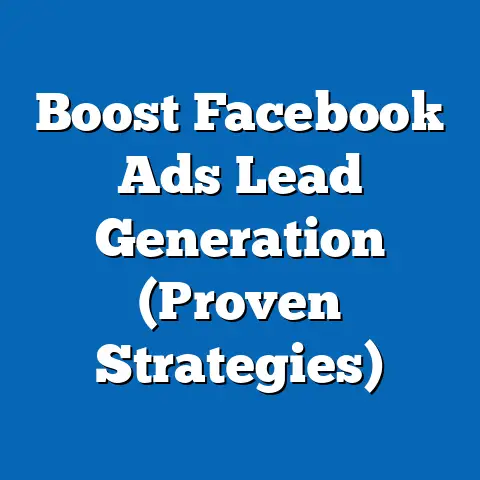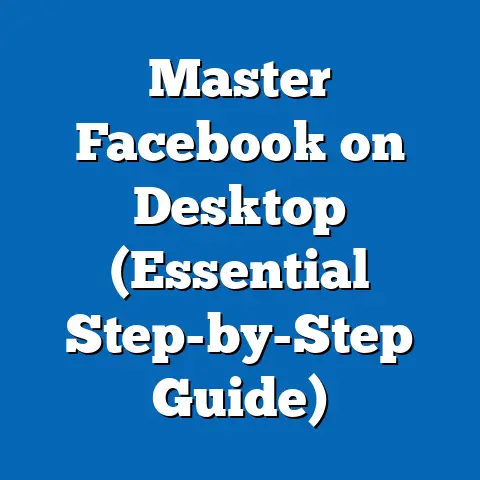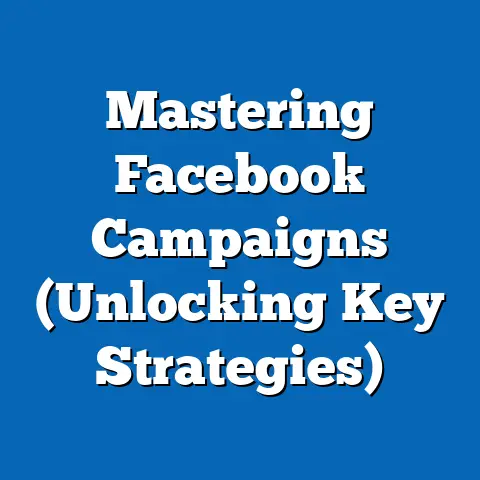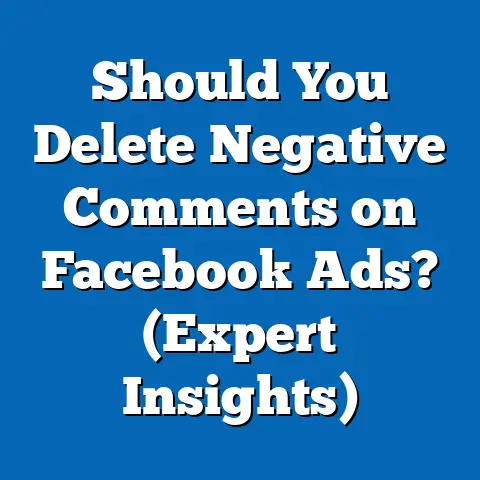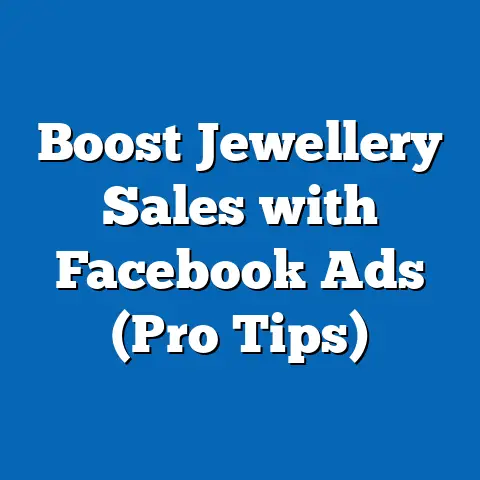Master Facebook Ads vs Boosting (Essential Insights)
In the ever-evolving world of digital marketing, businesses and advertisers face a myriad of tools and strategies to reach their target audiences. Among the most prominent platforms, Facebook (now under the Meta umbrella) stands out as a powerhouse for social media advertising, offering two primary options for promoting content: Facebook Ads and Boosting Posts. While both aim to increase visibility and engagement, they differ significantly in functionality, targeting precision, customization, and overall impact.
Section 1: Digital Advertising Trends and the Rise of Social Media Marketing
Digital advertising has undergone a seismic shift over the past two decades, driven by the rapid adoption of social media platforms. According to Statista, global digital ad spending reached $522 billion in 2021 and is projected to surpass $700 billion by 2025, with social media advertising accounting for a significant portion of this growth. Facebook, with over 2.9 billion monthly active users as of 2022, remains a dominant player, offering businesses unparalleled access to diverse demographics.
The trend toward personalized, data-driven advertising has reshaped how brands connect with consumers. Unlike traditional media, social platforms enable hyper-targeted campaigns based on user behavior, interests, and demographics. This shift has given rise to tools like Facebook Ads and Boosting, which cater to varying levels of advertiser expertise and budget.
Historically, digital advertising emerged in the late 1990s with banner ads and rudimentary pay-per-click models. The launch of Facebook in 2004 and its introduction of advertising options in 2007 marked a turning point, as businesses began leveraging social networks for direct engagement. Over time, Facebook refined its ad ecosystem, introducing sophisticated algorithms and machine learning to optimize campaign performance—a trend that continues to define the platform’s advertising tools today.
Societally, the rise of social media advertising has sparked debates over privacy, data ethics, and the influence of targeted content on consumer behavior. As platforms like Facebook collect vast amounts of user data, concerns about transparency and misinformation have grown, prompting regulatory scrutiny worldwide. These dynamics underscore the importance of understanding the tools available to advertisers and their broader implications.
Section 2: Defining Characteristics of Facebook Ads and Boosting
To grasp the differences between Facebook Ads and Boosting, it’s essential to define their core features, purposes, and functionalities. Both tools are designed to amplify reach on Facebook, but they cater to different needs and levels of complexity.
Facebook Ads: This is a comprehensive advertising platform accessible through Facebook’s Ads Manager or Business Manager. It allows advertisers to create highly customized campaigns across Facebook, Instagram, Messenger, and the Audience Network. Key characteristics include detailed targeting options (e.g., age, location, interests, behaviors), multiple ad formats (e.g., carousel, video, lead ads), and advanced optimization for objectives like conversions, traffic, or brand awareness.
Facebook Ads also offer robust analytics, enabling advertisers to track metrics such as cost-per-click (CPC), return on ad spend (ROAS), and audience insights. Campaigns can be tailored to specific budgets and schedules, with options for A/B testing to refine messaging and visuals. This tool is ideal for businesses seeking granular control over their advertising efforts.
Boosting Posts: Boosting, on the other hand, is a simplified feature available directly from a business’s Facebook Page. It allows users to promote existing organic posts to a larger audience for a set budget. Boosting is designed for ease of use, with limited targeting options (e.g., location, age, gender, interests) and minimal customization compared to Facebook Ads.
The primary goal of Boosting is to increase visibility and engagement (likes, comments, shares) for a specific post. While it provides basic insights into reach and engagement, it lacks the depth of analytics and optimization features found in Facebook Ads. Boosting is often favored by small businesses or individuals with limited marketing expertise or budgets.
In essence, Facebook Ads offer a full-scale, strategic approach to advertising, while Boosting serves as a quick, user-friendly way to amplify content. Understanding these distinctions is critical for advertisers aiming to align their tools with campaign goals.
Section 3: Historical Context and Evolution of Facebook’s Advertising Tools
The development of Facebook’s advertising ecosystem reflects broader shifts in technology and user behavior. When Facebook introduced its first ad product, “Flyers,” in 2007, it was a basic tool for promoting events and pages to local audiences. This early model laid the groundwork for more sophisticated offerings as the platform grew.
By 2012, Facebook launched the Ads Manager, a centralized hub for creating and managing campaigns. This coincided with the platform’s push into mobile advertising, capitalizing on the global surge in smartphone usage. The introduction of Custom Audiences and Lookalike Audiences in the following years allowed advertisers to target users based on uploaded data (e.g., email lists) or similar profiles, revolutionizing precision targeting.
Boosting emerged around 2012 as a lightweight alternative to full-scale ads, targeting small businesses and non-marketers who wanted to increase post visibility without navigating the complexities of Ads Manager. Initially, Boosting offered minimal customization, but over time, Facebook added basic targeting and budgeting options to enhance its utility.
Significant events, such as the 2018 Cambridge Analytica scandal, influenced the evolution of these tools by prompting stricter data privacy regulations like the General Data Protection Regulation (GDPR) in Europe. Facebook responded by enhancing transparency features and restricting certain targeting options, impacting how advertisers use both Ads and Boosting. Additionally, Apple’s iOS 14 update in 2021, which limited ad tracking, forced Meta to adapt its algorithms, emphasizing the importance of first-party data and creative optimization.
These historical milestones highlight how external pressures and technological advancements have shaped Facebook’s advertising tools. They also underscore the need for advertisers to stay agile in a landscape defined by rapid change.
Section 4: Technological and Economic Factors Influencing Usage
Technological Factors: The backbone of both Facebook Ads and Boosting is Meta’s powerful algorithm, which prioritizes content based on user relevance and engagement signals. For Facebook Ads, machine learning optimizes ad delivery to achieve specific objectives, such as maximizing conversions or minimizing costs. This level of automation requires advertisers to provide high-quality creative and clear campaign goals to achieve optimal results.
Boosting, by contrast, relies on a simpler algorithm focused on post engagement rather than complex objectives. Its limited targeting capabilities mean it often reaches a broader, less refined audience. Technological barriers also play a role—while Ads Manager demands a learning curve to master its features, Boosting’s accessibility makes it a go-to for beginners.
Economic Factors: Budget considerations heavily influence the choice between these tools. Facebook Ads allow for flexible spending, with options for daily or lifetime budgets and bids tailored to campaign goals. However, effective campaigns often require significant investment to compete in crowded markets. According to WordStream, the average CPC for Facebook Ads across industries was $1.72 in 2022, though costs vary widely by audience and objective.
Boosting, conversely, can be initiated with as little as $1 per day, making it an attractive entry point for small businesses or solopreneurs. However, its cost-effectiveness diminishes for larger campaigns, as limited targeting often results in lower return on investment (ROI). Economic disparities among businesses thus shape adoption patterns, with larger enterprises favoring Ads and smaller entities leaning toward Boosting.
These technological and economic dynamics illustrate the trade-offs between control and simplicity. Advertisers must weigh their resources and expertise when selecting the appropriate tool for their needs.
Section 5: Social and Cultural Implications of Advertising Choices
The decision to use Facebook Ads or Boosting extends beyond business outcomes, reflecting broader social and cultural trends. Socially, the ability to micro-target audiences through Facebook Ads raises ethical questions about manipulation and echo chambers. Highly personalized ads can influence consumer behavior and even political opinions, as seen in controversies surrounding election interference.
Boosting, while less precise, contributes to the democratization of advertising by enabling small businesses, local creators, and community organizations to amplify their voices. This aligns with cultural shifts toward supporting local economies and grassroots movements, particularly in the wake of global crises like the COVID-19 pandemic, which saw a surge in boosted posts from small businesses seeking to maintain visibility.
Culturally, the content promoted through these tools mirrors societal values and priorities. For instance, video ads and boosted posts often prioritize emotional storytelling or viral trends to capture attention in a crowded digital space. However, cultural nuances within target audiences must be considered—missteps in messaging can lead to backlash, as seen in high-profile ad controversies.
Both tools also reflect the growing expectation for authenticity in advertising. Consumers, particularly younger generations like Millennials and Gen Z, value transparency and alignment with social causes. Advertisers using either tool must navigate these cultural expectations to build trust and loyalty.
Section 6: Comparing Effectiveness Across Business Objectives
To evaluate the effectiveness of Facebook Ads versus Boosting, it’s useful to compare their performance across common business objectives: brand awareness, engagement, lead generation, and conversions.
Brand Awareness: Both tools can increase visibility, but Facebook Ads excel due to their ability to target specific demographics and use diverse ad formats like Stories or video ads. Boosting is effective for local awareness but often reaches a less relevant audience. Data from Hootsuite indicates that Ads achieve 30-50% higher reach for brand awareness campaigns compared to boosted posts.
Engagement: Boosting is inherently designed to drive likes, comments, and shares on a specific post, making it a strong choice for community-building. However, Ads can also drive engagement through interactive formats like polls or carousel ads, often with better cost efficiency for larger audiences.
Lead Generation and Conversions: Facebook Ads dominate in this arena, offering lead forms, pixel tracking, and retargeting capabilities to nurture prospects through the sales funnel. Boosting lacks the infrastructure to support detailed conversion tracking, limiting its utility for direct sales. A 2022 study by Social Media Examiner found that 68% of marketers using Facebook Ads reported positive ROI for conversion campaigns, compared to just 22% for Boosting.
These comparisons highlight that while Boosting offers quick wins for engagement and local reach, Facebook Ads provide superior results for strategic, long-term goals. Businesses must align their choice with their primary objectives and available resources.
Section 7: Nuances and Diversity in Usage Patterns
It’s important to acknowledge that usage of these tools varies widely based on industry, audience, and geographic context. For example, e-commerce brands often rely on Facebook Ads for retargeting and dynamic product ads, while local restaurants or service providers may find Boosting sufficient for promoting time-sensitive offers to nearby customers.
Demographic diversity also influences outcomes. Younger audiences on Instagram (reachable via Facebook Ads) may respond better to visually rich campaigns, while older users on Facebook might engage more with boosted posts featuring straightforward messaging. Cultural and regional differences further complicate targeting—advertisers in densely populated urban areas may face higher ad costs than those in rural markets.
Additionally, not all businesses have equal access to digital marketing expertise. Small business owners or nonprofits with limited budgets and training often default to Boosting, even if Ads might yield better results with proper management. This diversity underscores the need for tailored strategies rather than one-size-fits-all approaches.
Section 8: Implications for Businesses, Marketers, and Society
Business and Workplace Implications: For businesses, choosing between Facebook Ads and Boosting impacts marketing efficiency and bottom-line results. Larger companies with dedicated marketing teams can leverage Ads to scale campaigns and integrate them into broader digital strategies. Smaller entities, however, may find Boosting a practical starting point, though they risk wasting budget without clear goals.
In the workplace, the growing reliance on digital advertising has spurred demand for skills in data analysis, creative design, and platform-specific expertise. Marketers must adapt to frequent updates in Meta’s algorithms and policies, necessitating continuous learning and agility.
Societal Implications: The widespread use of targeted advertising tools raises critical questions about consumer autonomy and data privacy. While Facebook Ads enable precise outreach, they also contribute to concerns over surveillance capitalism. Boosting, though less invasive, still relies on user data, amplifying calls for stricter regulations like the California Consumer Privacy Act (CCPA).
Moreover, the accessibility of these tools has leveled the playing field for small businesses and marginalized voices, fostering economic inclusion. Yet, it also intensifies competition, as advertisers vie for limited user attention in an oversaturated digital space.
Section 9: Forward-Looking Insights and Uncertainties
Looking ahead, the trajectory of Facebook Ads and Boosting will likely be shaped by advancements in artificial intelligence, evolving privacy laws, and shifting user behaviors. Meta’s investment in AI-driven ad optimization suggests that both tools will become more intuitive, potentially blurring the lines between their functionalities. For instance, Boosting could gain more targeting options, while Ads might simplify onboarding for novices.
However, uncertainties remain. Regulatory pressures could limit data collection, forcing advertisers to pivot toward contextual targeting or zero-party data strategies. Additionally, the rise of competing platforms like TikTok and evolving consumer preferences (e.g., preference for ephemeral content) may challenge Facebook’s dominance, pushing Meta to innovate or risk losing market share.
For businesses, the key to future success lies in experimentation and adaptability. Testing both tools, analyzing performance data, and staying informed about platform updates will be essential. While Facebook Ads currently offer superior customization and ROI for complex campaigns, Boosting remains a valuable entry point for smaller players—an equilibrium that may shift as technology and policies evolve.
Conclusion: Striking a Balance in Digital Advertising
The comparison between Facebook Ads and Boosting reveals a spectrum of possibilities for digital advertisers, each with distinct strengths and limitations. Facebook Ads provide unmatched precision, scalability, and analytics, making them ideal for strategic campaigns with measurable outcomes. Boosting, conversely, offers simplicity and immediacy, catering to those seeking quick engagement with minimal effort.
Understanding these tools within the broader context of digital advertising trends, historical developments, and societal impacts equips businesses to make informed decisions. As the landscape continues to evolve, driven by technological innovation and regulatory changes, advertisers must remain flexible, prioritizing data-driven strategies over rigid adherence to one method.
Ultimately, the choice between Facebook Ads and Boosting is not binary but situational, hinging on goals, resources, and audience dynamics. By embracing a nuanced approach, marketers can harness the full potential of Meta’s advertising ecosystem, navigating its complexities to achieve meaningful connections in an increasingly digital world.

